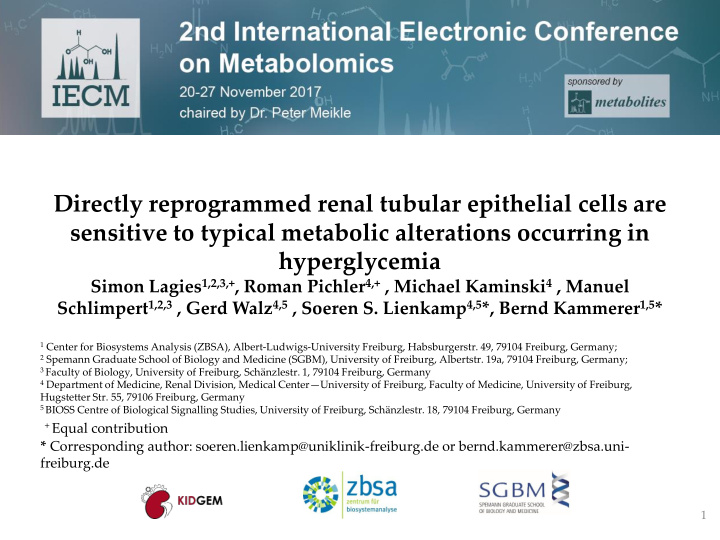



Directly reprogrammed renal tubular epithelial cells are sensitive to typical metabolic alterations occurring in hyperglycemia Simon Lagies 1,2,3,+ , Roman Pichler 4,+ , Michael Kaminski 4 , Manuel Schlimpert 1,2,3 , Gerd Walz 4,5 , Soeren S. Lienkamp 4,5 *, Bernd Kammerer 1,5 * 1 Center for Biosystems Analysis (ZBSA), Albert-Ludwigs-University Freiburg, Habsburgerstr. 49, 79104 Freiburg, Germany; 2 Spemann Graduate School of Biology and Medicine (SGBM), University of Freiburg, Albertstr. 19a, 79104 Freiburg, Germany; 3 Faculty of Biology, University of Freiburg, Schänzlestr. 1, 79104 Freiburg, Germany 4 Department of Medicine, Renal Division, Medical Center — University of Freiburg, Faculty of Medicine, University of Freiburg, Hugstetter Str. 55, 79106 Freiburg, Germany 5 BIOSS Centre of Biological Signalling Studies, University of Freiburg, Schänzlestr. 18, 79104 Freiburg, Germany + Equal contribution * Corresponding author: soeren.lienkamp@uniklinik-freiburg.de or bernd.kammerer@zbsa.uni- freiburg.de 1
Directly reprogrammed renal tubular epithelial cells are sensitive to typical metabolic alterations occurring in hyperglycemia Endo- and MEFs exometabolite extraction Reprogramming Glucose treatment iRECs MEFs: Glucose accumulation iRECs: Glucose metabolization - Glycolysis Data analysis - TCA cycle - polyol-pathway GC-MS untargeted profiling 2
Abstract: Forced expression of four transcription factors is sufficient to reprogram mouse embryonic fibroblasts (MEFs) directly to induced renal tubular epithelial cells (iRECs). These cells have been characterized as tubule cells by transcriptomic, morphological and functional studies. Recently, we analyzed kidney tubule cells by untargeted metabolomics, which further supported their cellular identity. Hence, application of a common nephrotoxic agent let to changes that also occur in vivo [in submission]. In this study, we investigated the impact of glucose on MEFs and iRECs by conducting an untargeted gas chromatography/mass spectrometry based profiling with high and low glucose concentrations. Whereas accumulating in MEFs, glucose was efficiently metabolized by glycolysis and citric acid cycle in iRECs but also an increase in the polyol pathway was observed. The activation of this pathway and a consequent generation of reactive oxygen species is a common phenomenon in diabetic complications such as diabetic retinopathy, neuropathy and nephropathy (DN). Thus, iRECs transpired to be an excellent in vitro model for tubule damage, an aspect of DN being overshadowed by the glomerular focus. The possibility to generate iRECs also from human fibroblasts holds great potential in patient specific testing for exogenous challenges in general. Keywords: Metabolomics; Mass-Spectrometry; Direct Reprogramming; In vitro modelling 3
Introduction • Mouse embryonal fibroblasts (MEFs) can be directly reprogrammed to renal tubular epithelial cells (iRECs) by forced expression of four transcription factors: Hnf1b, Hnf4a, Emx2 and Pax8. • Identity was proven by several approaches. MEFs iRECs • Recently, we confirmed the metabolic identity of iRECs to other renal epithelial cells and hence validated the metabolic behavior on a functional level in response to a nephrotoxic agent (submitted). Kaminski et al., Nat. Cell Biol., 2016 4
Methods • Metabolite extraction: • Cells with -20°C MeOH:H 2 O 9:1 • Medium with -20°C ACN:MeOH 3:1 • Vacuum dried pellet derivatized by methoxyamine and MSTFA • GC-EI-MS full scan with 60 min chromatography program • Annotation: Retention index variation < 5%, Match Score > 750 • Normalization: internal standard (phenylglucose) and peaksum, range scaling • Statistics: PCA and heat-maps. Heat-maps show metabolites with ANOVA q<0.05 5
Results: Global differences in intracellular glucose response • Global differences in iRECs upon high glucose • Minor differences (PC3) additionally in MEFs 6
Results: specific response to intracellular glucose treatment Glucose • High glucose levels are metabolized in iRECs but not in MEFs via glycolysis and TCA cycle. • Sorbitol/glucitol Sorbitol accumulates in iRECs after high glucose treatment. Cluster glycolysis and TCA cycle 7
Results: Excreted metabolites differed slightly, no global effect Lactate Glucose • Extracellular glucose concentration did not show prominent differences in both cell lines. • Enhanced lactate excretion only in iRECs. • PCA revealed no global differences (not shown). 8
Conclusions Glucose seems to be taken up by both MEFs and iRECs. However, glucose accumulates in MEFs while it is metabolized in iRECs. Increases in intermediates of glycolysis and the TCA cycle were observed in iRECs. This is supported by the extracellular lactate levels. Additionally, glucitol/sorbitol is enriched in iRECs in hyperglycemic conditions. Sorbitol accumulation is a typical phenomenon of diabetic complications. We thus suggest iRECs to be a good model system to monitor metabolic alterations upon exogenous challenges such as hyperglycemia but also nephrotoxic agents. As it is possible to generate human iRECs, personalized or disease specific responses can be tested which might lead to personalized treatment. Zeni et al., J Nephrol., 2017 Liew et al., Curr Diab Rep., 2017 Adeshara et al., Curr Drug Targets., 2016 9
Acknowledgments The Collaborative Research Centre (SFB) KIDGEM 1140 “ Kidney Disease – From Genes to Mechanisms” Spemann Graduate Center for School of Biology and Biological System Medicine Analysis 10
Recommend
More recommend